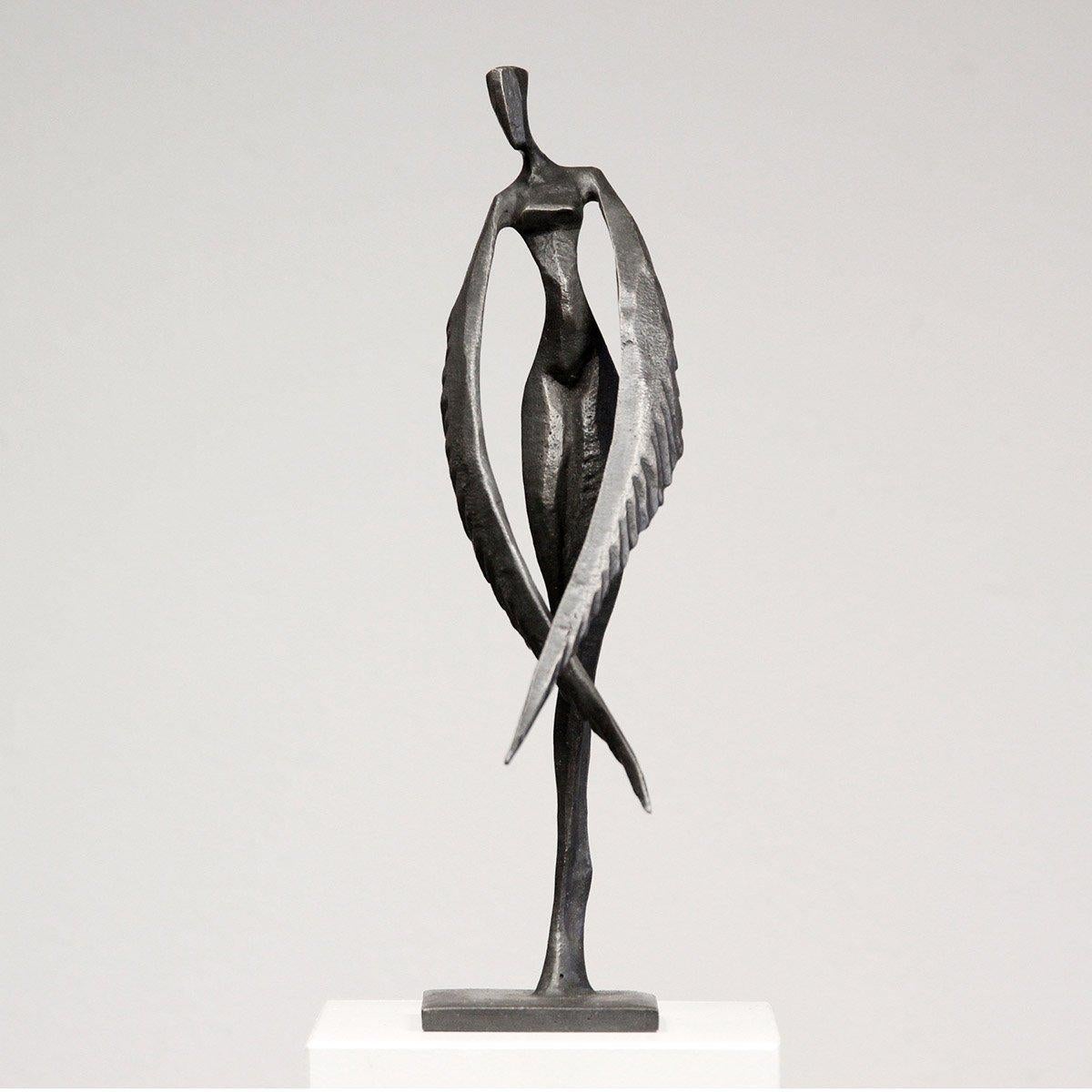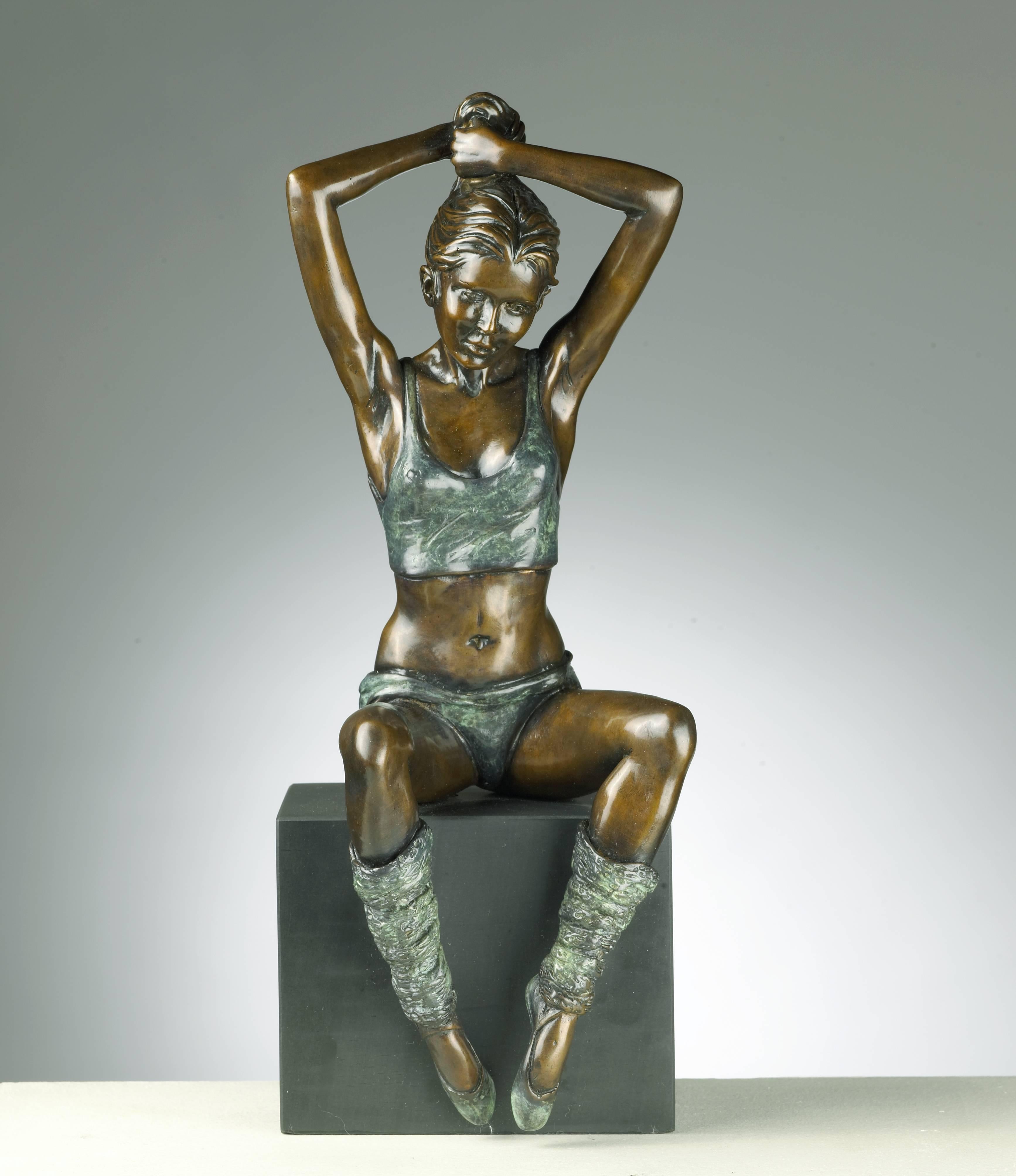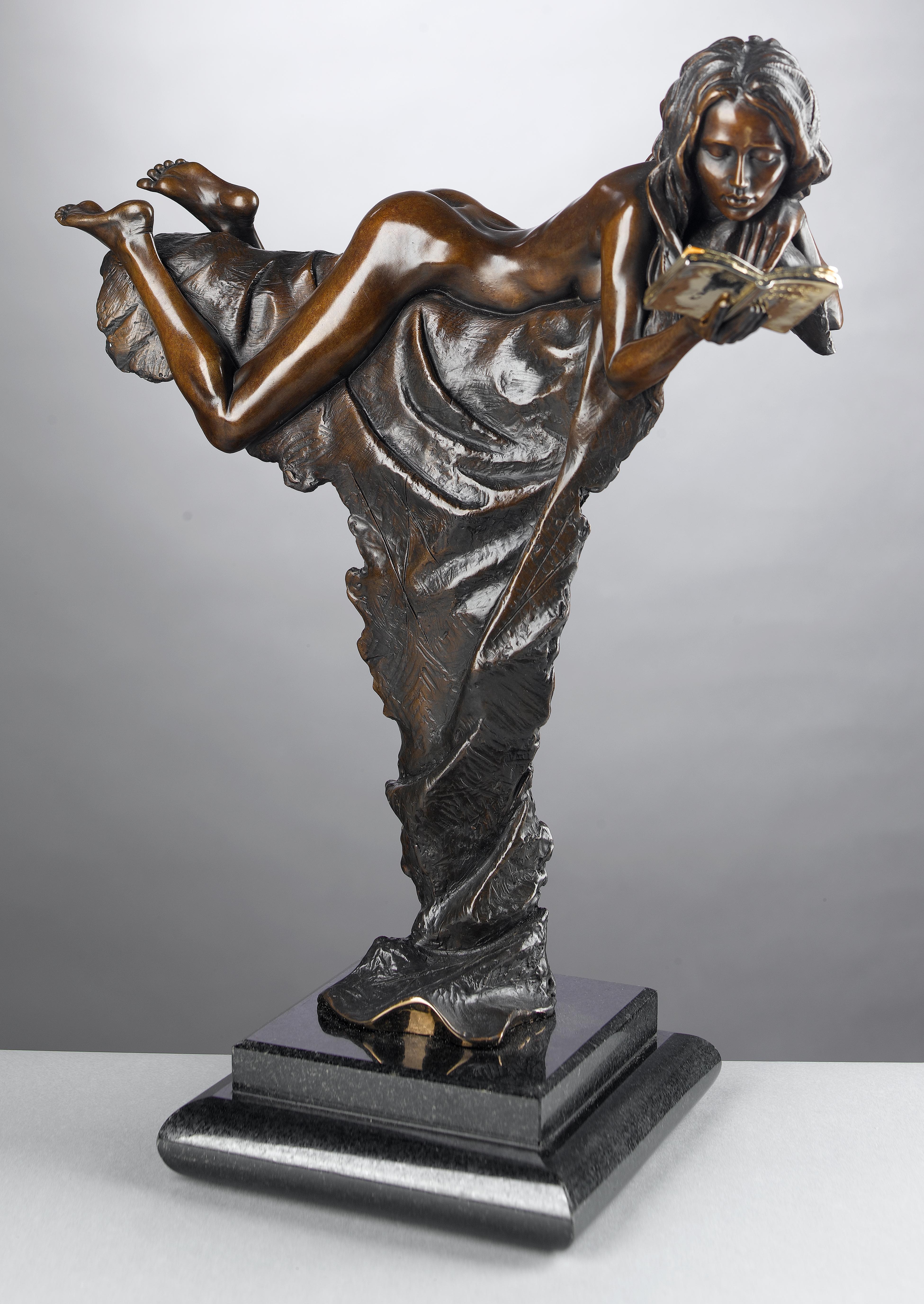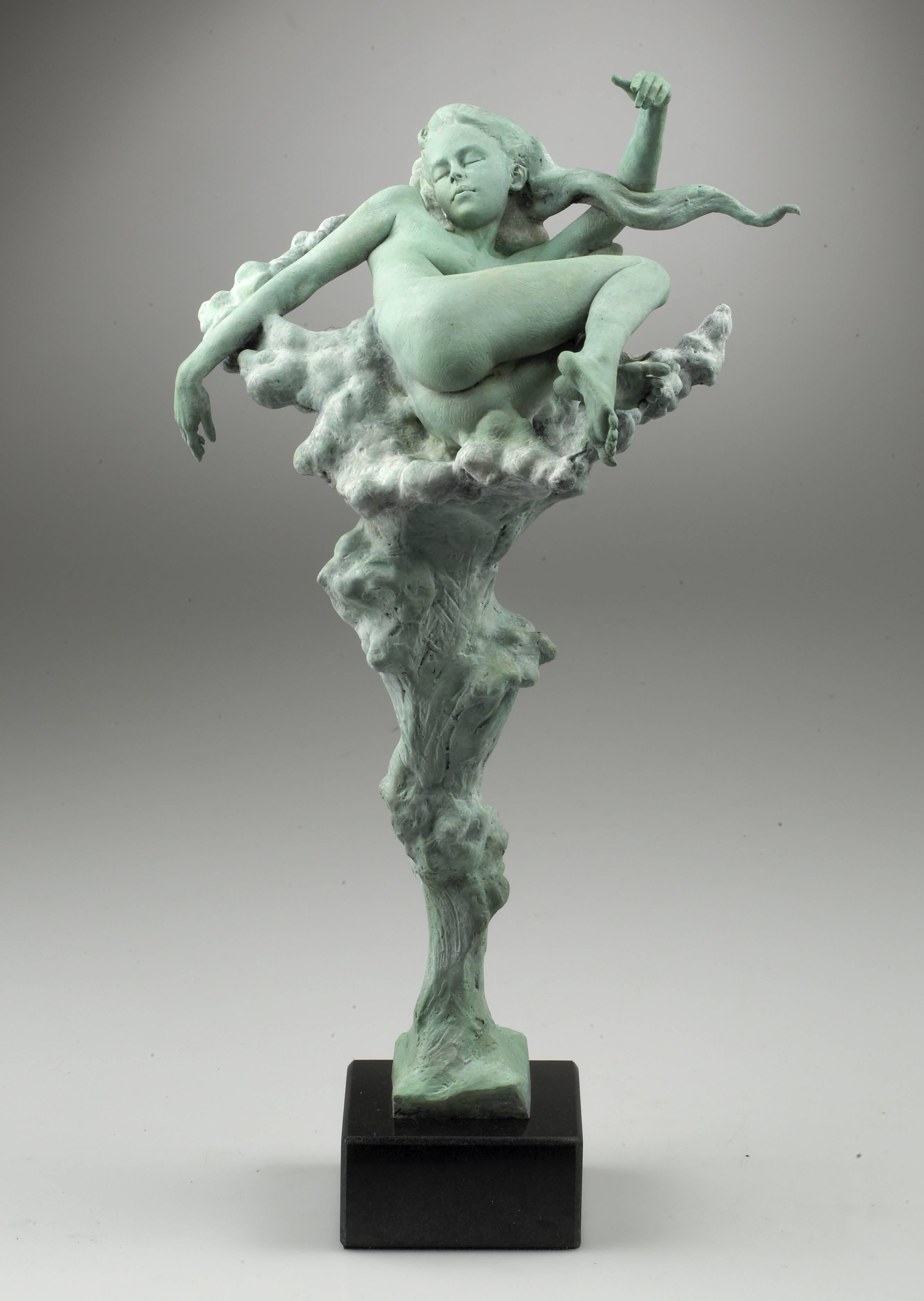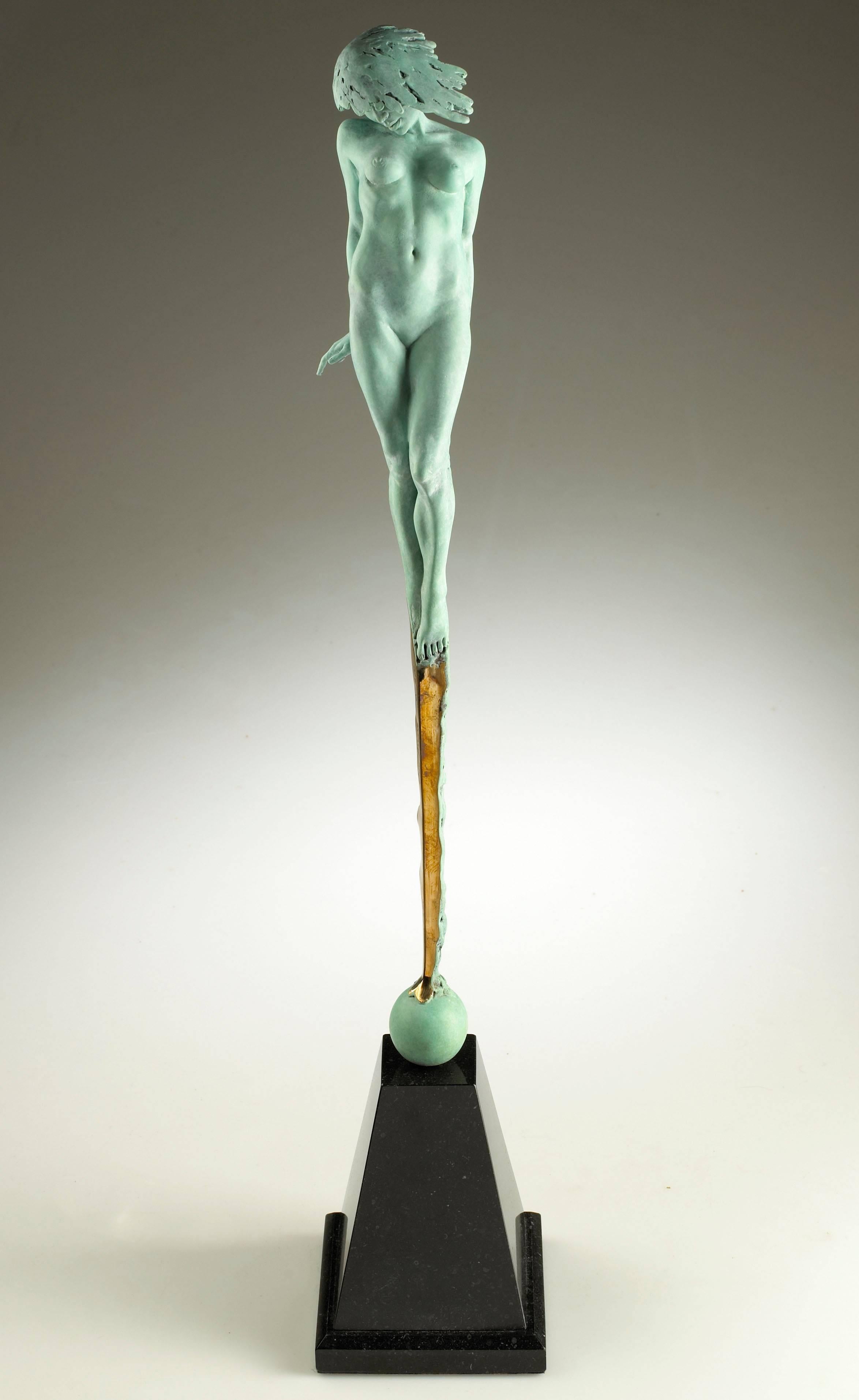Items Similar to L'Enfer des Luxurieux, The Hell of the Luxurious Relief, 19th Century Bronze.
Want more images or videos?
Request additional images or videos from the seller
1 of 11
Jean-François Garnier L'Enfer des Luxurieux, The Hell of the Luxurious Relief, 19th Century Bronze.c.1859-1864
c.1859-1864
About the Item
A rare round relief cast, elaborate chiseled bronze/copper with brown patina by Jean François Marie Garnier (1820-1895). Cast c.1859-1864. Not signed. The motif is taken from Dantes, The Divine Comedy´s, first part, Inferno and the second circle, called "L'Enfer des Luxurieux", in english "The Hell of the Luxurious". See identical relief, signed Jean Garnier, in Musée d'Orsay in Paris, inventory no. OA 3666, also belonging to the Louvre collections. Another cast of the relief is part of the Museum of Lyon collections. Framed in a 19th century stained oak frame. The dimensions are the exact as the one in Musée d'Orsay. Later copies, of which a few are known, usually have a larger diameter and lesser quality in casting etc.
The relief, L'Enfer des Luxurieux, in the Musée d'Orsay collection, was exhibited 2023-2024 during the exhibition: Louis Janmot, "The Poem of the Soul", in french 'Le Poème de l’âme'.
From the introduction text of the exhibition:
"The Poem of the Soul" suit was begun in Rome in 1835 and completed in 1881, The Poem of the Soul is the crowning achievement of the Lyonese artist Louis Janmot (1814-1892), a pictorial and literary work all in one. In 34 compositions accompanied by a long poem, it illustrates a soul’s initiatory journey on Earth.
Garnier and Janmot were both from Lyon and they probably knew each other and Garnier was likely inspired by Janmot´s work. Jean Francois Marie Garnier was born in Lyon and died in Paris. He is sometimes mixed up with another artist, with a very similar name, Alfred Jean Garnier (1848-1921).
During the 19th century, particularly with romanticism, then symbolism, the representation of the soul took on considerable importance. Artists respond in varied ways to the same iconographic problem: how to represent an immaterial entity, distinct from the body and having an existence beyond death? In turn, the soul takes the form of a winged female figure, an allegory of purity and spirituality, or materializes in the form of a shadow or a flow escaping from the body.
The second circle, in Dantes Inferno, depicted in this relief shows the fate of the damned souls, also called the “lustful”. The souls in this circle is to be swept away by relentless winds. All people guilty of the sin of lust are whirled round and round in an unending storm. The storm, represents irresistible passion. Among those being blown about are mythic and historical queens. The sin of these souls is that of having submitted reason to their carnal appetites, of having committed the sin of the flesh. Among them are the souls of Semiramis, Cleopatra, Dido, Helen of Troy, Paris, Tristan, Francesca da Rimini and Paolo Malatesta.
The two center figures embracing each other in the relief depicts Francesca da Rimini and Paolo Malatesta.
The Divine Comedy is a literary masterpiece written by Dante Alighieri (1265-1321) in the first half of the 14th century. The Comedy symbolises humankind’s journey for redemption through the three afterlife kingdoms: Inferno, Purgatory and Paradise.
While Purgatory and Paradise are embedded with theological and philosophical considerations, Inferno is a testimony of the political corruption at that time. Italy was the battlefield for the political fights between the Pope and the Emperor. It was one of the most merciless ‘Games of Thrones’ in medieval history.
Dante tells the story of many political and religious figures, who – blinded by political ambitious – committed murders, cannibalism, treason, and suicide all in the name of ‘worldly power’.
In a sense, Dante’s Inferno is the first attempt to challenge the dominant social imaginary through storytelling. Dante is aware that unless humanity achieves spiritual redemption, his world will be forever lost in the wood of sins and corruption.
Each circle that constitutes Hell introduces characters that embed a specific characteristic of the dominant imaginary that needs to be criticized. The only exception can be found in Canto V (chapter V), in which – only on this occasion- Dante took pity of two condemns: Paolo and Francesca di Rimini.
Canto V is the testimony of Dante’s powerful narrative technique that triggers empathy in the readers. Even though Paolo and Francesca committed adultery and therefore had to be put in the circle of the lustful, their love story is so moving that the readers conceive them as the innocent victims of a dreadful/unjust fate.
Francesca di Rimini was a beautiful noble girl – destined to become a nun – but she was kidnapped and forced to marry the violent Gianciotto Malatesta, Paolo’s older brother. While living together, Paolo and Francesca fell in love. Unfortunately, the brother discovered their affair and killed the two lovers, condemning his brother and his wife to an eternity in Hell. Nevertheless, Paolo and Francesca’ sin becomes secondary to the readers because what really matters is that their life was brutally interrupted. Paolo and Francesca can be finally together and free to live their love but they have to go through eternal suffering.
In this Canto, Dante uncommonly employs a sweet, romantic and poetic language. The words are characterized by a slow rhythm that creates emphasis and pathos to the story. The readers are capable of creating an emotional connection with the characters and cannot help identifying themselves with the pain and sorrow these two star-crossed lovers have to go through every day to be together.
Paolo and Francesca’s story is an outstanding example of the emotional power of language that may open doors to change and better justice.
- Creator:Jean-François Garnier (1820 - 1895, French)
- Creation Year:c.1859-1864
- Dimensions:Height: 1.19 in (3 cm)Diameter: 20.87 in (53 cm)
- Medium:
- Movement & Style:Symbolist
- Period:
- Condition:There are a few breakage places on the outer rim of the cast, one barely visible by the frame edge.
- Gallery Location:Stockholm, SE
- Reference Number:1stDibs: LU2608213929842
About the Seller
5.0
Gold Seller
These expertly vetted sellers are highly rated and consistently exceed customer expectations.
1stDibs seller since 2023
6 sales on 1stDibs
Typical response time: 1 hour
- ShippingRetrieving quote...Ships From: Stockholm, Sweden
- Return PolicyA return for this item may be initiated within 14 days of delivery.
More From This SellerView All
- Elephant Sculpture, Bronze, Mother and Baby Elephant 19th Century, Marble Base.Located in Stockholm, SEA fine patinated bronze sculpture of a mother elephant with her baby elephant by Niels Holm (1860-1933). Signed NIELS HOLM, ELEPHASINDICUS, ENDANGER. Also signed L. RASMUSSEN, KOBENH...Category
Late 19th Century Naturalistic Figurative Sculptures
MaterialsMarble, Bronze
- 16th Century Cameo Pendant of Christ the Redeemer in a Gilt Bronze FrameLocated in Stockholm, SEA finely carved 16th or early 17th century large hard stone pendant cameo of Christ the Redeemer in profile. Set in period a gilt bronze frame. Possibly Italian. The profile view of...Category
16th Century Italian School Figurative Sculptures
MaterialsPrecious Stone
- Still life, Fruits and Roses. 19th Century Oil on canvas.Located in Stockholm, SEA still life with fruits and roses painted by the danish painter Emil C. Ulnitz (1856-1933) A fine example of the Danish still life painting...Category
Late 19th Century Still-life Paintings
MaterialsCanvas, Oil
- Still Standing Stream with Shading Trees and Sunlit Clearing, 19th century oil.By Christian ZachoLocated in Stockholm, SEA still standing stream with shading trees and a sunlit opening over the water painted by Peter Mørch Christian Zacho (1843 - 1913). Oil on canvas laid on board. Signed C.Z. Probably...Category
Late 19th Century Impressionist Landscape Paintings
MaterialsCanvas, Oil, Board
- Goosander Birds On Ice Floes. Oil on Canvas 1918Located in Stockholm, SEA female and male Goosander bird on ice floes. In the center of the painting there is a smaller opening in the ice covered waters. This painting, by Christian Berg (1893-1976) is quite interesting and unusual for his works. It is signed "Ch. Berg" and dated 1918. Berg is mostly famous for his sculptures which was to become his signum works later in his life. He is known primarily for his abstract artworks. He was educated at the Technical School and Althin's painting school in Stockholm 1911–1914. In the years 1914–1917 he studied at the Royal Academy of Fine Arts and started with animal painting in the spirit of Bruno Liljefors. Our painting is from this period just after he finished his studies at the Royal Academy of Fine Arts. In 1921, he studied in Berlin and Dresden which was followed by a trip to Egypt in 1925. In the same year he moved to Paris and had a studio on rue Guénégaud. He studied with André Lhote and his interest in cubism was awakened. Made sketch drawings at the free academies Colarossi and La Grande Chaumière and in 1927 he met the Swedish artist Erik Olson...Category
1910s Naturalistic Animal Paintings
MaterialsCanvas, Oil
- Spanish Flamenco Dancing Women in Garden, Oil on Canvas.Located in Stockholm, SEA fine painting of a group of Spanish flamenco dancing and music playing women in a garden outside a house painted by Allan Österlind (1855-1938). Oil ...Category
Early 20th Century Other Art Style Figurative Paintings
MaterialsCanvas, Oil, Board
You May Also Like
- Fleur – Charlotte by Nando Kallweit. Bronze sculpture, Edition of 50By Nando KallweitLocated in Coltishall, GBFleur – Charlotte is an elegant figurative bronze sculpture by Nando Kallweit. Inspired by the the legend of the phoenix, this female figure has graceful wings instead of arms. The...Category
21st Century and Contemporary Other Art Style Figurative Sculptures
MaterialsBronze
- 20th Century Solid Bronze Nude Ballet Dancer 'Preparation' by Benson LandesBy Benson LandesLocated in Shrewsbury, Shropshire'Preparation' is a 20th Century Solid Bronze ballet Dancer by Benson Landes. For Benson Landes, sculpture was most definitely a passion. His oeuvre of cast bronzes is populated wit...Category
Late 20th Century Realist Nude Sculptures
MaterialsBronze
- 'Libri' Figurative Nude bronze Sculpture of a Woman reading a book, dancer, goldBy Carl PayneLocated in Shrewsbury, Shropshire'Libri' is a stunning sculpture by the hugely talented Carl Payne. Payne has a talent to create a real feeling of movement and lightness in his Bronze sculptures, no small feat! Continuing a successful career in England and Ireland, Carl joined Callaghan Fine Paintings and Works of Art at the beginning of 2004 in order to dedicate his time to create and develop stunning individual contemporary sculpture. Carl is a Staffordshire based sculptor for whom art has played a large part in his academic work taking him through the Burslem School of Art, the Henry Doulton School of Sculpture and then to Stafford College. After qualifying in Figurative Sculpture he launched his career with commission after commission which has now secured his reputation for fine quality workmanship both in life-size format and smaller decorative pieces. The list of his completed commissioned work is extensive, including many ‘house-hold’ names from the sporting world, commerce and the past. The following are just some of the private and publicly commissioned completed works that form Carl’s prestigious portfolio:- King George 5th and Queen Mary – life size portrait buste commissioned by Cunards Cruise Ships and located in the ballroom of the Queen Mary 2 (QM2) cruise ship. Ride a Cock Horse to Banbury Cross – life size and a quarter commissioned by Banbury Council, located at Banbury Cross and unveiled by Princess Anne. Randolph Turpin – life size and a quarter - commissioned by Warwick and Leamington Spa Council located in Warwick Town Centre, Sir Stanley Matthews – life size and a half - commissioned by the Stanley Matthews Foundation located at The Britannia Stadium, Stoke. George Best...Category
21st Century and Contemporary Nude Sculptures
MaterialsBronze
- Nude Figurative Bronze Contemporary Sculpture 'Lazy Summer' by Carl PayneBy Carl PayneLocated in Shrewsbury, Shropshire'Lazy Summer' is a stunning sculpture by the hugely talented Carl Payne. The model featured in the sculpture is the artist's wife, who is a professional dancer. Payne has a talent to create a real feeling of movement and lightness in his Bronze sculptures, no small feat! Continuing a successful career in England and Ireland, Carl joined Callaghan Fine Paintings and Works of Art at the beginning of 2004 in order to dedicate his time to create and develop stunning individual contemporary sculpture. Carl is a Staffordshire based sculptor for whom art has played a large part in his academic work taking him through the Burslem School of Art, the Henry Doulton School of Sculpture and then to Stafford College. After qualifying in Figurative Sculpture he launched his career with commission after commission which has now secured his reputation for fine quality workmanship both in life-size format and smaller decorative pieces. The list of his completed commissioned work is extensive, including many ‘house-hold’ names from the sporting world, commerce and the past. The following are just some of the private and publicly commissioned completed works that form Carl’s prestigious portfolio:- King George 5th and Queen Mary – life size portrait buste commissioned by Cunards Cruise Ships and located in the ballroom of the Queen Mary 2 (QM2) cruise ship. Ride a Cock Horse to Banbury Cross – life size and a quarter commissioned by Banbury Council, located at Banbury Cross and unveiled by Princess Anne. Randolph Turpin – life size and a quarter - commissioned by Warwick and Leamington Spa Council located in Warwick Town Centre, Sir Stanley Matthews – life size and a half - commissioned by the Stanley Matthews Foundation located at The Britannia Stadium, Stoke. George Best...Category
21st Century and Contemporary Contemporary Nude Sculptures
MaterialsBronze
- Contemporary Nude Bronze Sculpture 'Le Pucelle' by Carl PayneBy Carl PayneLocated in Shrewsbury, Shropshire'Le Pucelle' by Carl Payne is a stunning Contemporary Nude Bronze Sculpture. Continuing a successful career in England and Ireland, Carl joined Callaghan Fine Paintings and Works o...Category
21st Century and Contemporary Nude Sculptures
MaterialsBronze
- Bronze sculpture "Soulmates II"By ShrayLocated in Palm Beach, FLBronze sculpture by a renowned American artist - Shray Shray continues her exploration of her bronze works using a black patina that recasts her sculpture's impact on negative spac...Category
2010s Abstract Expressionist Figurative Sculptures
MaterialsBronze
Recently Viewed
View AllMore Ways To Browse
Round Relief
Antique Relief Sculpture
Wood Relief Sculpture
Relief Doors
Bronze Nude Figure
Antique Bronze Nude
Antique Nude Bronze
Bronze Relief Large
Brutal Sculptures
The Lovers Bronze
Relief Nude
How To Submit
Wood Relief Door
Antique Emperor Sculpture
The Embrace Bronze Sculpture
Nude Female Sculptures Large
Erotic Bronze
Large Wing Sculpture
